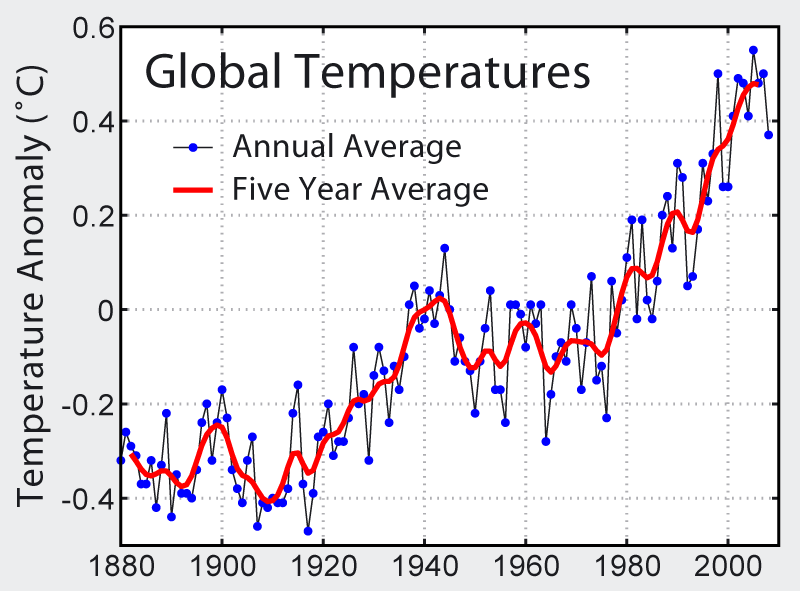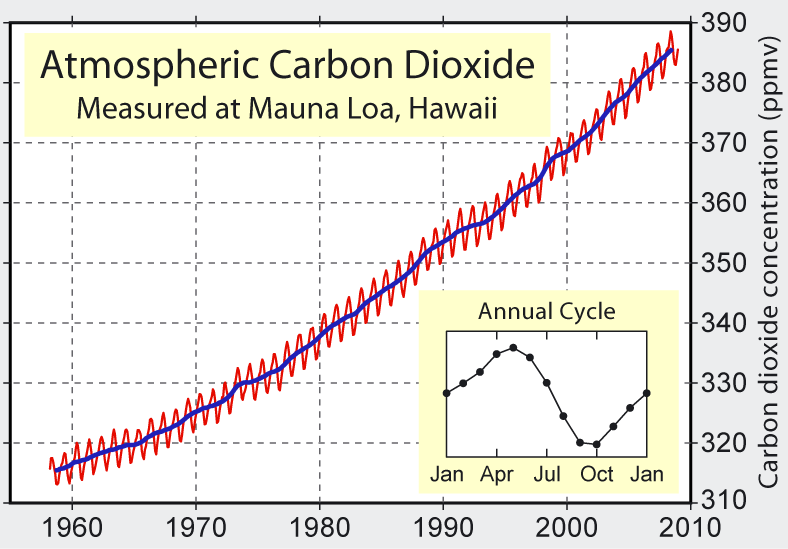From Skeptical Science:
The Greenhouse Effect
The Earth is a giant rock, hurtling through space in its orbit around the sun. It would be a frozen lifeless rock like the moon if not for the thin layer of atmosphere that traps solar energy and insulates the Earth’s surface, like a transparent blanket. The way the atmosphere traps solar energy is called (somewhat inaccurately) the Greenhouse Effect, because the effect is similar to a greenhouse or a closed car heating up in the sun. Sunlight comes in through a transparent window and is absorbed by whatever it hits, heating up the interior. Some of that heat is trapped inside, partly because glass is less transparent to heat than it is to light, and the temperature increases. In the atmosphere, sunlight is absorbed by the Earth’s surface or rooftops or whatever, and that energy is radiated as heat (infrared energy) back toward space. Most of that heat doesn’t make it to space, because it gets absorbed by certain gases in the atmosphere, mainly water vapor, carbon dioxide, and methane. Normally this is a good thing, because without the heat trapped in the atmosphere by “greenhouse gases”, our planet would be frozen. But it turns out that too much of a good thing is a bad thing. If extra carbon dioxide that is not part of the natural carbon cycle is added to the atmosphere, then extra heat is trapped that would otherwise escape to space, and the atmosphere gets warmer. So in a nutshell, Global Warming is an increase in the Earth’s overall average temperature caused by adding extra carbon dioxide and other greenhouse gases to the atmosphere that absorb and trap heat.
Average Global Temperature 1880-2009

Figure 1: Average global temperature during the period 1880-2009, compiled from various data sources by NASA. Zero in this figure corresponds to the average global temperature for the period 1961-1990. The red curve is a 5-year average that smooths the year-to-year variability. All measurements are imperfect for a variety of reasons, including accuracy limitations of the instrumentation, and sampling uncertainty from incomplete data coverage. The uncertainty analysis for this dataset gives an estimated increase in the average global temperature over the 20th century of 0.57±0.17°C, where ±0.17°C is the uncertainty in the estimate at the 95% confidence level.
Figure created by Robert Rohde from published data for Global Warming Art, where references for the data sources and analysis methods are given.
Carbon Dioxide
Carbon dioxide (or CO2) is the familiar gas that bubbles out of carbonated beverages, and in its solid form it’s called dry ice. Carbon dioxide is also a waste product of animal metabolism, after oxygen from the air is combined with carbon-containing compounds in food to produce the energy we need to live. In a beautiful carbon cycle, plants take in carbon dioxide and solar energy to live, and they “exhale” the oxygen that we need to live. For most of human existence, the amount of CO2 in the atmosphere has been stable at about 280 parts per million (ppm), meaning that out of every million molecules in the air, 280 of them are carbon dioxide. It’s a pretty small fraction of the atmosphere (0.028%), but it’s the right amount of carbon dioxide to absorb just enough heat so that the Earth has the overall average temperature that we and everything else have gotten used to.
Then came the Industrial Revolution, when we learned to make the great amounts of electricity and heat needed to build modern civilization by burning “fossil fuels”, or coal, oil, and natural gas (methane). Fossil fuels are the remains of plants and animals that died millions of years ago and sank to the bottom of stagnant water that lacked the oxygen needed to decompose them, so they became buried under layer after layer of sediment and compressed into coal or oil. Today we mine that coal and drill for oil and then burn them in power plants and cars. Fossil fuels are mostly made of carbon, and burning them turns them into carbon dioxide that goes up the smoke stack or out the tailpipe and into the atmosphere. This is the extra carbon dioxide, beyond that nice amount we used to have when the carbon cycle was in balance, that is causing global warming. Carbon dioxide doesn’t just go away, it builds up in the atmosphere and traps more heat and makes the planet warmer. The amount of carbon dioxide in the atmosphere in 2010 was 390 ppm (Fig. 2), which is up 39% from pre-industrial levels, and it’s increasing at a rate of 1.9 ppm/year as more and more humans burn more and more fossil fuels. It’s astonishing that humans can have such a large effect on the whole planet’s atmosphere, but it’s a fact that they do.
Direct CO2 Measurements 1958-2009

Figure 2: Concentration of atmospheric carbon dioxide measured at Mauna Loa, Hawaii from 1958 to 2009. The red curve shows monthly measurements of CO2 concentration in parts per million (ppm), and the blue curve is the annual average. The seasonal cycle is caused by the respiration (breathing) of all Earth’s plants, where there is more plant activity in the northern-hemisphere summer to take in CO2 and reduce its concentration in the atmosphere. The 280 ppm CO2 concentration prior to the industrial revolution had increased to 315 ppm by 1958, and by 2010 it was 390 ppm and increasing, mostly in response to increased burning of fossil fuels and deforestation. Deforestation is linked with global warming because fewer plants on Earth means less CO2 is removed, so its concentration in the atmosphere remains higher. This graph is known as the Keeling curve, after Charles David Keeling who maintained this excellent record over the years. This is the first significant evidence of rapidly increasing CO2 levels in the atmosphere, and Keeling is often credited with first bringing to the world’s attention the effect that human activity is having on the Earth’s atmosphere and climate.
Figure created by Robert Rohde from published data for Global Warming Art.
Read the rest of this piece here
Leave a Reply